Digital Substations: Optimization Opportunities from Communication Architectures and Emerging Technologies
Abstract
1. Introduction
- The work provides a comprehensive and objective analysis of emerging technological trends and communication architectures in DESs, identifying optimization opportunities from both technical and operational perspectives. This study benefits from a collaborative approach between academia, research institutions, and industry experts, ensuring a balanced and practice-oriented vision.
- Qualitative and quantitative analyses of communication architectures in DESs are performed, demonstrating a potential reduction of up to 50% in communication equipment through a proposed universal bus architecture, validated by laboratory tests.
- An empirical evaluation of centralized protection and control (CPC) systems reveals response times up to 60% faster (e.g., <1 ms for GOOSE messaging) than some distributed IEDs in multivendor setups, improving scalability and efficiency.
- Traffic optimization strategies using Software-Defined Networking (SDN) are identified, reducing bandwidth saturation risks under high traffic conditions, and introducing cybersecurity improvements that would support the development of universal buses.
2. Background
2.1. Conventional Technologies in DES
2.2. Communication Architectures
2.3. Emerging Technologies for DES
- Flexibility in management: It allows centralized and dynamic network reconfiguration according to traffic needs.
- Enhanced security: It facilitates network segmentation and automatic real-time responses to possible cyberattacks.
- Resource optimization: It reduces hardware complexity and minimizes operating costs by eliminating complex local configurations.
- High availability and resilience: It detects failures and automatically redirects traffic, ensuring operational continuity.
- Real-time monitoring: it allows continuous network monitoring, identifying potential failures and bottlenecks.
- Interoperability: It promotes compatibility between devices from different manufacturers, simplifying integration.
- Integration of new technologies: It facilitates the adoption of new technologies without disrupting the existing infrastructure.
- Equipment reduction: It decreases the number of physical devices in the substation.
- Space optimization: It allows the reduction of physical space and simpler installations.
- Simplified maintenance: It facilitates lower maintenance costs and more efficient management.
- Increased flexibility: It facilitates adaptation to operational or technological changes through software, without the need to modify the hardware.
- Improved resilience: It enables faster response to failures and more efficient system recovery.
- Interoperability: It provides an improved integration of devices and technologies from multiple manufacturers by standardizing communications and functions.
- Scalability: It enables faster growth without large investments in physical infrastructure.
3. Methodology
- Integration and interoperability (according to IEC 61850) between protection, control, and supervision devices, focusing on multivendor systems.
- Performance evaluation of protection and control equipment (IEC 61850-10).
- Evaluation of protocol conversion to supervisory systems.
- Evaluation of interoperability and performance in communication systems.
- Evaluation of the performance of the CPC system.
- Traffic analysis, packet loss, or anomalies in information transfer.
- Application of traffic management (Quality of Service—QoS) through segmentation using VLAN and MAC-Multicast filtering.
4. Results and Analysis
4.1. Lab Test—Preliminary Results
4.2. Initial Optimization Alternatives
4.3. Proposed Architectures
5. Discussion
Impacts and Risks Derived from the Proposed Alternatives
- Greater simplicity of the system: In the proposed architectures, by integrating all devices with connection to a universal communication bus, their integration is considerably simplified, and their accessibility is improved, from the same central point that can be any of the communication equipment (LAN A or LAN B) proposed in the architecture.
- Greater flexibility: By combining the information with the DES, it becomes feasible to improve protection, control, and measurement systems. This includes incorporating new bays or parallel technologies for performance assessment or integration with the current system.
- Cost reduction: Leaving aside the separation of process and station buses in the DES implies a decrease in equipment and communication channels and spaces in boards destined for the infrastructure. In turn, this can have a greater impact, if a centralized protection system is implemented or, as shown in Figure 14, a main protection server with its corresponding backup.
- Greater volume of traffic: A common point for integrating all devices into the system implies that the information from this equipment converges at that point. This is why the volume of traffic increases considerably in space if the integration of multiple bays with the process bus in a DES is considered. In this case, it is required that the communication infrastructure used be able to tolerate and process the levels of information that it will face.
- Greater information management: A large traffic volume requires greater control, particularly when its totality is not necessarily relevant for all devices that are part of the DES infrastructure. Therefore, it is necessary to perform engineering work that optimally guides the information to be exchanged exclusively between the devices that require it. This reduces the processing load and mitigates the risks of loss or saturation in the network due to high volumes of data.
- Greater IT security management: The simplicity of the system and its accessibility to its devices also imply a risk that must be controlled in DESs. Therefore, it is necessary to implement effective cybersecurity and access control policies for the different devices to mitigate the risks of vulnerability or unwanted actions in the operation of DESs.
- Cybersecurity: By centralizing control and using programmable networks, substations become more vulnerable to cyberattacks, which could compromise critical protection and control systems.
- Single point of failure: Consolidating functions on a single device or server (CPC or SDN) means that a failure in the centralized system could affect multiple protections and controls simultaneously.
- Implementation complexity: SDN networks and programming protections in CPC require advanced architecture and trained personnel, which can initially increase the complexity of deployment and maintenance.
- Latency: In solutions such as SDN and CPC or VPAC, network latency can affect the response time of protection systems, compromising the speed of actions in the event of power grid failures.
- Interoperability: Although SDN and CPC improve interoperability, the integration of technologies from multiple manufacturers can generate incompatibilities or communication problems if standards are not met adequately.
- Virtualization reliability: Virtual environments could generate risks related to the stability and performance of the underlying hardware, compromising critical operations if infrastructure failures occur.
6. Conclusions
- The study and characterization of communication technologies and architectures currently applied to DESs show that companies incur significant costs associated with excessive redundancies in communication equipment and protocols. Limitations of this research include reliance on laboratory tests, limiting generalizability, and cost estimates based on average vendor data.
- DESs require experts to design, operate, and maintain facilities. Knowledge of the communication component is relevant for selecting technologies, designing, and configuring different elements of DESs. Therefore, specialized courses are required to qualify people for employment in these facilities.
- The appropriate use of technology and knowledge on topics such as SDN or centralized protections can represent an important advance in optimizing the use and performance of these systems.
- Communication architectures for DESs, which integrate conventional architectures with redundancy protocols, efficient traffic management, and technologies for centralized protection in electrical substations, reduce costs in new implementations, and evaluate the performance of the different components of a DES to make implementation viable.
- It is crucial to communicate the knowledge gained from the experience in utilities to regulatory entities. These entities are important in incentivizing investments in such topologies, leading to improved service quality, CO2 emission indicators, cybersecurity, and overall profitability of companies. These findings support improved service quality and profitability through optimized DES designs.
Author Contributions
Funding
Institutional Review Board Statement
Informed Consent Statement
Data Availability Statement
Acknowledgments
Conflicts of Interest
References
- Aftab, M.A.; Hussain, S.M.; Ali, I.; Ustun, T.S. IEC 61850 based substation automation system: A survey. Int. J. Electr. Power Energy Syst. 2020, 120, 106008. [Google Scholar] [CrossRef]
- Guo, R. Design and Optimization of Digital Substation Integrated Automation System Based on Improved Genetic Algorithm. In Proceedings of the Proceedings—2023 International Conference on Power, Electrical Engineering, Electronics and Control, PEEEC 2023, Athens, Greece, 25–27 September 2023; pp. 41–46. [Google Scholar] [CrossRef]
- Aljohani, T.; Almutairi, A. Modeling Time-Varying Wide-Scale Distributed Denial of Service Attacks on Electric Vehicle Charging Stations. Ain Shams Eng. J. 2024, 15, 102860. [Google Scholar] [CrossRef]
- Ashraf, S.; Shawon, M.H.; Khalid, H.M.; Muyeen, S.M. Denial-of-Service Attack on IEC 61850-Based Substation Automation System: A Crucial Cyber Threat Towards Smart Substation Pathways. Sensors 2021, 21, 6415. [Google Scholar] [CrossRef] [PubMed]
- Efiong, J.E.; Akinwale, A.; Akinyemi, B.O.; Olajubu, E.; Aderounmu, S. CyberGrid: An IEC61850 Protocol-Based Substation Automation Virtual Cyber Range for Cybersecurity Research in the Smart Grid. Cyber-Phys. Syst. 2024, 11, 47–66. [Google Scholar] [CrossRef]
- Rahat, R.M.; Hasan Imam, M.; Das, N. Comprehensive Analysis of Reliability and Availability of Sub-Station Automation System with IEC 61850. In Proceedings of the 2019 International Conference on Robotics, Electrical and Signal Processing Techniques (ICREST), Dhaka, Bangladesh, 10–12 January 2019; pp. 406–411. [Google Scholar] [CrossRef]
- Vardhan, H.; Ramlachan, R.; Szela, W.; Gdowik, E. Deploying digital substations: Experience with a digital substation pilot in North America. In Proceedings of the 2018 71st Annual Conference for Protective Relay Engineers (CPRE), College Station, TX, USA, 26–29 March 2018; pp. 1–9. [Google Scholar] [CrossRef]
- Std. IEC 61850; Communication Networks and Systems for Power Utility Automation. International Electrotechnical Commission: Geneva, Switzerland, 2023.
- Tobar-Rosero, O.A.; Roa-Romero, O.A.; Rueda-Carvajal, G.D.; Leal-Piedrahita, A.; Botero-Vega, J.F.; Gutierrez-Betancur, S.A.; Branch-Bedoya, J.W.; Zapata-Madrigal, G.D. GOOSE Secure: A Comprehensive Dataset for In-Depth Analysis of GOOSE Spoofing Attacks in Digital Substations. Energies 2024, 17, 6098. [Google Scholar] [CrossRef]
- Daboul, M.; Orságová, J. Evaluation IEC 61850 Protocols based Protection Schemes of Digital Substation. In Proceedings of the 2023 23rd International Scientific Conference on Electric Power Engineering, EPE 2023, Brno, Czech Republic, 24–26 May 2023. [Google Scholar] [CrossRef]
- Mlynek, P. Communication Testbed for Smart Substations. Int. Congr. Ultra Mod. Telecommun. Control. Syst. Work. 2022, 2022, 128–132. [Google Scholar] [CrossRef]
- Soares, A.A.; Lopes, Y.; Fernandes, N.C.; Muchaluat-Saade, D.C.; Mosse, D. Enabling Digital Twins for Smart Substation Networks. In Proceedings of the 2023 IEEE International Conference on Communications, Control, and Computing Technologies for Smart Grids, SmartGridComm 2023—Proceedings, Glasgow, UK, 31 October–3 November 2023. [Google Scholar] [CrossRef]
- Ingalalli, A.; Silpa, K.S.; Gore, R. SCD based IEC 61850 traffic estimation for substation automation networks. In Proceedings of the 2017 22nd IEEE International Conference on Emerging Technologies and Factory Automation (ETFA), Limassol, Cyprus, 12–15 September 2017; pp. 1–8. [Google Scholar] [CrossRef]
- Ustun, T.S.; Aftab, M.A.; Ali, I.; Hussain, S.M.S. A Novel Scheme for Performance Evaluation of an IEC 61850-Based Active Distribution System Substation. IEEE Access 2019, 7, 123893–123902. [Google Scholar] [CrossRef]
- Tobar Rosero, O.A.; Santamaria Isaza, R.J.; Dario Zapata Madrigal, G.; Olaya, J.C. Relevant aspects for interoperability in electrical substations under implementation of process bus IEC 61850-9-2 with multi-vendor devices. In Proceedings of the 2019 FISE-IEEE/CIGRE Conference—Living the energy Transition (FISE/CIGRE), Medellin, Colombia, 4–6 December 2019; IEEE: Piscataway, NJ, USA, 2019. [Google Scholar]
- Habib, H.; Fawzy, N.; Brahma, S. Hardware in the Loop Testing of a Protection Scheme for Microgrid using RTDS with IEC 61850 Protocol. In Proceedings of the 2020 IEEE Industry Applications Society Annual Meeting, Detroit, MI, USA, 10–16 October 2020; pp. 1–8. [Google Scholar] [CrossRef]
- Ingram, D.M.E.; Schaub, P.; Taylor, R.R.; Campbell, D.A. Performance Analysis of IEC 61850 Sampled Value Process Bus Networks. IEEE Trans. Ind. Inform. 2013, 9, 1445–1454. [Google Scholar] [CrossRef]
- Valtari, J.; Verho, P.; Hakala-Ranta, A.; Saarinen, J. Increasing cost-efficiency of substation automation systems by centralised protection functions. In Proceedings of the IET Conference Publications, Dublin, Ireland, 10–11 June 2009; IET: London, UK, 2009. [Google Scholar]
- Santos, G.R.; Zancul, E. A framework to assess the impacts of digital electrical substations. Smart Energy 2023, 12, 100125. [Google Scholar] [CrossRef]
- Cabral, E.A.; Tofoli, F.L.; Sampaio, R.F.; Leão, R.P.S. Reliability assessment applied in the design of an industrial substation in the context of Industry 4.0. Electr. Power Syst. Res. 2024, 231, 110365. [Google Scholar] [CrossRef]
- Vasudevan, B.; Groat, J.; Vandiver, B. Testing Challenges of a Complete PAC Digital Substation. In Proceedings of the 2023 76th Annual Conference for Protective Relay Engineers, CFPR 2023, College Station, TX, USA, 27–30 March 2023. [Google Scholar] [CrossRef]
- Xu, L.; Li, H.; Dong, F.; Zhou, Y. Evaluación de los Métodos de Control de Flujo de Datos y su Rendimiento en Subestaciones Digitales basadas en IEC61850. In Proceedings of the 2019 IEEE 8th International Conference on Advanced Power System Automation and Protection (APAP), Xi’an, China, 21–24 October 2019; pp. 1408–1412. [Google Scholar] [CrossRef]
- Stinskiy, A.; de Oliveira, E. Digital Substation with Process Bus—A Comparative Review of IEC61850-9-2 and IEC 61869-9 Standards. In Proceedings of the 2024 77th Annual Conference for Protective Relay Engineers (CFPR), College Station, TX, USA, 25–28 March 2024; pp. 1–5. [Google Scholar] [CrossRef]
- Zhang, Y.; Cai, Z.; Li, X.; He, R. Analytical Modeling of Traffic Flow in the Substation Communication Network. IEEE Trans. Power Deliv. 2015, 30, 2119–2127. [Google Scholar] [CrossRef]
- Oliveira, L.B.; Zapella, M.; Sarda, A.; Zanatta, W. Managed Ethernet switches performance over IEC 61850 networks: Applications with high traffic flow. In Proceedings of the 13th International Conference on Development in Power System Protection 2016 (DPSP), Edinburgh, UK, 7–10 March 2016; pp. 1–6. [Google Scholar] [CrossRef]
- Praveen, A.N.; Swarup, K.S.y.S.S. Cálculo de la latencia de comunicación en una subestación compleja basada en IEC 61850. In Proceedings of the 2021 9th Conferencia Internacional IEEE sobre Sistemas de Potencia (ICPS), Kharagpur, India, 16–18 December 2021. [Google Scholar] [CrossRef]
- Steinhauser, F.; Wiecha, A. Behaviour of IEC 61850 protection relays under degraded network traffic conditions. In Proceedings of the 16th International Conference on Developments in Power System Protection (DPSP 2022), Newcastle, UK, 7–10 March 2022; Volume 2022, pp. 268–272. [Google Scholar] [CrossRef]
- Comisión-Nacional-de Energía, C. ANEXO TÉCNICO—Exigencias Mínimas de Diseño de Instalaciones de Transmisión, CNE-Chile. 2020. Available online: https://www.cne.cl/wp-content/uploads/2020/09/EXIGENCIAS-M%C3%8DNIMAS-DE-DISE%C3%91O-DE-INSTALACIONES-DE-TRANSMISI%C3%93N.pdf, (accessed on 22 July 2024).
- Operador Nacional del Sistema Eléctrico, O. Submódulo 2.11—Requisitos mínimos para os sistemas de proteção, de registro de perturbações e de teleproteção, Despacho ANEEL nº 1.580/2024. 2024. Available online: https://www2.aneel.gov.br/cedoc/adsp20241580_2_1.pdf (accessed on 22 July 2024).
- Arias-Giraldo, T. Evaluación, Selección y anáLisis de Arquitecturas de Comunicación para Subestaciones Digitales y su Aplicación en Empresas del Sector Eléctrico. Master’s Thesis, Universidad Nacional de Colombia—sede Medellín, Medellín, Colombia, 2020. [Google Scholar]
- Samitier, C. Utility Communication Networks and Services; Springer International Publishing: Cham, Switzerland, 2017. [Google Scholar] [CrossRef]
- Docquier, T.; Song, Y.Q.; Chevrier, V.; Pontnau, L.; Ahmed-Nacer, A. Performance evaluation methodologies for Smart Grid Substation Communication Networks: A survey. Comput. Commun. 2023, 198, 228–246. [Google Scholar] [CrossRef]
- Ayello, M.; Lopes, Y. Interoperability based on IEC 61850 standard: Systematic literature review, certification method proposal, and case study. Electr. Power Syst. Res. 2023, 220, 109355. [Google Scholar] [CrossRef]
- Santos, G.R.; Zancul, E.; Manassero, G.; Spinola, M. From conventional to smart substations: A classification model. Electr. Power Syst. Res. 2024, 226, 109887. [Google Scholar] [CrossRef]
- IEC/TC57; Communication Networks and Systems for Power Utility Automation—Part 90-4: Network Engineering Guidelines. International Electrotechnical Commission: London, UK, 2020. Available online: www.iec.ch (accessed on 28 February 2025).
- De Klerk, M.L.; Saha, A.K. A Review of the Methods Used to Model Traffic Flow in a Substation Communication Network. IEEE Access 2020, 8, 204545–204562. [Google Scholar] [CrossRef]
- Gómez-Luna, E.; Tobar-Rosero, O.A.; Piñeros-Saldarriaga, J.F.; Hernández-Fúquene, F.; Quintero-Pineda, M.; Castillo-Bautista, W.; Molina-Castro, J.D.; Giraldo-Arenas, C.M. Implementation of the IEC 61850 standard in Colombia—Requirements and challenges in the implementation of digital substations. ELECTRA, October 2024. [Google Scholar]
- Muñoz, P. La Digitalización es el Siguiente Paso en la Evolución de las Subestaciones Eléctricas–CIGRE–Comité Chileno. 2020. Available online: https://www.cigre.cl/2020/09/03/la-digitalizacion-es-el-siguiente-paso-en-la-evolucion-de-las-subestaciones-electricas/ (accessed on 28 February 2025).
- IEC 62439-3; Industrial Communication Networks—High Availability Automation Networks—Part 3: Parallel Redundancy Protocol (PRP) and High-Availability Seamless Redundancy (HSR). International Electrotechnical Commission: Geneva, Switzerland, 2021.
- CIGRE-Colombia WG 5.8. Necesidades, Requerimientos y Desafíos en la Implementación de Subestaciones Digitales en Colombia (Implementación del estáNdar IEC 61850). 2020. Available online: http://www.cigrecolombia.org/Documents/Documentos-t%C3%A9cnicos/DT-B5.8-Subestaciones%20digitales.pdf (accessed on 5 July 2023).
- Das, N.; Islam, S. Analysis of power system communication architectures between substations using IEC 61850. In Proceedings of the 5th Brunei International Conference on Engineering and Technology (BICET 2014), Bandar Seri Begawan, Brunei, 1–3 November 2014; Institution of Engineering and Technology: London, UK, 2014. [Google Scholar]
- Bouffard-Vercelli, Y.E.; Andre, B. Future Architectures of Electrical Substations. In Proceedings of the Petroleum and Chemical Industry Conference Europe Conference Proceedings, PCIC EUROPE, Düsseldorf, Germany, 17–19 July 2021. [Google Scholar] [CrossRef]
- Gutiérrez, S.A.; Botero, J.F.; Gómez, N.G.; Fletscher, L.A.; Leal, A. Next-Generation Power Substation Communication Networks: IEC 61850 Meets Programmable Networks. IEEE Power Energy Mag. 2023, 21, 58–67. [Google Scholar] [CrossRef]
- Leal, A.; Durán, M.; Botero, J.F. Reliability provision in software defined power substations communication networks. Comput. Netw. 2020, 181, 107560. [Google Scholar] [CrossRef]
- Molina, E.; Jacob, E.; Matias, J.; Moreira, N.; Astarloa, A. Using Software Defined Networking to manage and control IEC 61850-based systems. Comput. Electr. Eng. 2015, 43, 142–154. [Google Scholar] [CrossRef]
- Cankaya, H.C. Software Defined Networking and Virtualization for Smart Grid. In Transportation and Power Grid in Smart Cities; John Wiley & Sons.: Hoboken, NJ, USA, 2018; pp. 171–190. [Google Scholar] [CrossRef]
- Makrakis, G.M.; Roberson, D.; Kolias, C. WIPP: Towards IEC 62443-3-3 Network Compliance via Software-Defined Networking in Digital Substations. In 2023 Resilience Week, RWS 2023; IEEE: Piscataway, NJ, USA, 2023. [Google Scholar] [CrossRef]
- Girdhar, M.; Hong, J.; Su, W.; Herath, A.; Liu, C.C. SDN-Based Dynamic Cybersecurity Framework of IEC-61850 Communications in Smart Grid. In Proceedings of the 2024 IEEE Power & Energy Society General Meeting (PESGM), Seattle, WA, USA, 21–25 July 2024; pp. 1–5. [Google Scholar] [CrossRef]
- Mustafa, H.M.; Basumallik, S.; Fetsick, R.; Srivastava, A. Using SDN to Enhance Cyber Resiliency in IEC 61850-based Substation OT Networks. In Proceedings of the 2023 IEEE International Conference on Energy Technologies for Future Grids, ETFG 2023, Wollongong, Australia, 3–6 December 2023. [Google Scholar] [CrossRef]
- Ayodele, B.; Buttigieg, V. SDN as a defence mechanism: A comprehensive survey. Int. J. Inf. Secur. 2024, 23, 141–185. [Google Scholar] [CrossRef]
- Makrakis, G.M.; Roberson, D.; Kolias, C.; Cook, D. Evaluation of SDN security measures in the context of IEC 62443-3-3. Int. J. Crit. Infrastruct. Prot. 2024, 47, 100716. [Google Scholar] [CrossRef]
- Sanchez-Acevedo, S.; D’Arco, S. A SDN Based Method for Blocking Malicious Attacks on Digital Substations Communication. In Proceedings of the Proceedings—2022 IEEE 5th International Conference on Industrial Cyber-Physical Systems, ICPS 2022, Coventry, UK, 24–26 May 2022. [Google Scholar] [CrossRef]
- Leal, A.; Botero, J.F. Defining a Reliable Network Topology in Software-Defined Power Substations. IEEE Access 2019, 7, 14323–14339. [Google Scholar] [CrossRef]
- Das, R.; Kanabar, M.; Adamiak, M.; Apostolov, A.; Antonova, G.; Brahma, S.; Zadeh, M.D.; Hunt, R.; Jester, J.; Kezunovic, M.; et al. Advancements in Centralized Protection and Control Within a Substation. IEEE Trans. Power Deliv. 2016, 31, 1945–1952. [Google Scholar] [CrossRef]
- Work-Group, IEEE PES PSRC K15 Centralized Substation Protection & Control | Report of Working Group K15 of the Substation Protection Subcommittee, IEEE PES. 2019. Available online: https://www.pacw.org/centralized-substation-protection-control (accessed on 6 September 2024).
- Halim, S.B.A.; Hatta, M.K.B.M.; Hussein, H.H.B.W.; Shafe’i, F.B.; Azmi, N.A.B.; Othman, F.B. Centralized Protection and Control (CPC): Next Level Of Electrical Protection System Towards Digital Substation (Oil and Gas). In Proceedings of the 2023 IEEE 3rd International Conference in Power Engineering Applications: Shaping Sustainability Through Power Engineering Innovation, ICPEA 2023, Putrajaya, Malaysia, 6–7 March 2023; pp. 285–290. [Google Scholar] [CrossRef]
- Wójtowicz, R.; Kowalik, R.; Rasolomampionona, D.D. Next generation of power system protection automation-Virtualization of protection systems. IEEE Trans. Power Deliv. 2018, 33, 2002–2010. [Google Scholar] [CrossRef]
- Carvalho, R.; Antunes, M.; Barraca, J.P.; Gomes, D.; Aguiar, R.L. Design and Evaluation of a Low-Latency CPC Environment for Virtual IEDs. In Proceedings of the 2022 IEEE Conference on Cloud Networking 2022, CloudNet 2022, Paris, France, 7–10 November 2022; pp. 272–276. [Google Scholar] [CrossRef]
- Rahman, A.; Yilmaz, O.; Vaze, O.; Mandal, A. Smart Substation Control and Protection Facilitating the Virtualization of Multiple Protection and Control. In Proceedings of the 2023 IEEE International Conference on Energy Technologies for Future Grids, ETFG 2023, Wollongong, Australia, 3–6 December 2023. [Google Scholar] [CrossRef]
- Aleixo, A.C.; Jorge, R.D.; Gomes, F.; Antunes, L.; Barraca, J.P.; Carvalho, R.; Antunes, M.; Gomes, D.; Gouveia, C.; Carrapatoso, A.; et al. Challenges and considerations for the design and implementation of a centralized protection and control solution for MV networks. In IET Conference Proceedings; The Institution of Engineering and Technology: Stevenage, UK, 2023; pp. 3328–3332. [Google Scholar] [CrossRef]
- Ganoo, P.; Joshi, S.; Valtari, J.; Niveri, H. Centralized Protection and Control System: Are We Ready for Deployment in the Chemical, Oil, and Gas Industry? IEEE Ind. Appl. Mag. 2022, 28, 48–61. [Google Scholar] [CrossRef]
- Torres, E.; Eguia, P.; Abarrategi, O.; Larruskain, D.M.; Valverde, V.; Buigues, G. Trends in Centralized Protection and Control in Digital Substations. In Proceedings of the 21th International Conference on Renewable Energies and Power Quality (ICREPQ’23), Madrid, Spain, 24–26 May 2023. [Google Scholar] [CrossRef]
- Valtari, J.; Joshi, S. Centralized Protection and Control, ABB—White Paper. 2020. Available online: https://www.pacw.org/centralized-protection-control-uncovering-the-potential (accessed on 28 February 2025).
- Flores, E.; Xavier, J.; Niveri, H. Centralized protection and control-Enhancing reliability, availability, flexibility and improving operating cost-efficiency of distribution substations. ABB. White Paper. 2023. Available online: https://library.e.abb.com/public/6b4a135b4c0f4e7f9b4898bdfca37131/White_paper_SSC600_2NGA001420_ENa.pdf (accessed on 28 February 2025).
- Nhung-Nguyen, H.; Girdhar, M.; Kim, Y.H.; Hong, J. Machine-Learning-Based Anomaly Detection for GOOSE in Digital Substations. Energies 2024, 17, 3745. [Google Scholar] [CrossRef]
- Eynawi, A.; Mumrez, A.; Elbez, G.; Hagenmeyer, V. Machine Learning-Based Feature Selection for Intrusion Detection Systems in IEC 61850-Based Digital Substations. In Proceedings of the 2024 IEEE International Conference on Communications, Control, and Computing Technologies for Smart Grids, SmartGridComm 2024, Oslo, Norway, 17–20 September 2024; pp. 1–7. [Google Scholar] [CrossRef]
- Li, J.; Su, H.; Zhang, Y.; Yan, Q.; Liu, L.; Wang, T. Smart Digital Inspection and Maintenance of Substations. In Proceedings of the 2024 5th International Conference on Power Engineering, ICPE 2024, Shanghai, China, 13–15 December 2024; pp. 388–393. [Google Scholar] [CrossRef]
- Yegorov, P.K.; Lackovitch, A.; Dean, E.; Mustafa, H.M.; Basumallik, S.; Srivastava, A. Analyzing GOOSE Security in IEC61850-based Substation Using ML, SDN and Digital Twin. In Proceedings of the 2023 North American Power Symposium, NAPS 2023, Asheville, NC, USA, 15–17 October 2023. [Google Scholar] [CrossRef]
- Tobar-Rosero, O.A. GOOSE Secure | Dataset. 2024. Available online: https://ieee-dataport.org/documents/goose-secure (accessed on 28 February 2025).
- Posada-Corrales, J.M. Process Bus Scalability with MU and Emulated SV | Dataset. 2025. Available online: https://ieee-dataport.org/documents/process-bus-scalability-mu-and-emulated-sv (accessed on 28 February 2025).
- Tobar-Rosero, O.A.; Candelo-Becerra, J.E.; Zapata, G. Performance analysis of overcurrent protection in a digital substation with process bus. Sustain. Sci. Pract. Policy 2022, 14, 7958. [Google Scholar] [CrossRef]
- Fernandez, J.S.C.; Carvajal, G.D.R.; Rosero, O.A.T.; Becerra, J.E.; Madrigal, G.D.Z.; Sierra, R.G. Dynamic Protection Scheme in a Digital Environment of Electrical Systems. In Proceedings of the Proceedings—2023 IEEE Latin-American Conference on Communications, LATINCOM 2023, Panama City, Panama, 17–19 November 2023. [Google Scholar] [CrossRef]
- Justino, F.M.; Tobar-Rosero, O.A.; Rueda-Carvajal, G.D.; Diaz-Vargas, P. Análisis de interoperabilidad y rendimiento con sistema de control y protección centralizado en subestaciones digitales: Un estudio de caso con el SSC600 de ABB. XVII SEMINÁRIO TÉCNICO DE PROTEÇÃO E CONTROLE. October 2024. Available online: https://stpc.com.br/programacao/ (accessed on 28 February 2025).
- Rosero, Ó.T.; Carvajal, G.D.R.; Célis, H.A.F.; González, E.P.; Vega, J.F.B.; Bedoya, J.W.B. Importancia de la gestión del tráfico como una primera medida de ciberseguridad en redes inteligentes. In Proceedings of the Encuentro Internacional de Educación en Ingeniería, Cartagena, Colombia, 24–27 September 2024; pp. 1–13. [Google Scholar] [CrossRef]
- Thompson, A.C. The Future of Substations: Centralized Protection and Control. Ph.D. Thesis, Virginia Polytechnic Institute and State University, Blacksburg, VA, USA, 2016. [Google Scholar]
- Udren, E.A.; Vandiver, B.; Anderson, J.; Antonova, G.; Apostolov, A.; Beaumont, P.; Beresh, R.; Brunner, C.; Calero, F.; Chelmecki, C.; et al. Application of Ethernet Networking Devices Used for Protection and Control Applications in Electric Power Substations: Report of Working Group P6 of the Power System Communications and Cybersecurity Committee of the Power and Energy Society of IEEE. In Proceedings of the 2021 74th Conference for Protective Relay Engineers, CPRE 2021, College Station, TX, USA, 22–25 March 2021. [Google Scholar] [CrossRef]

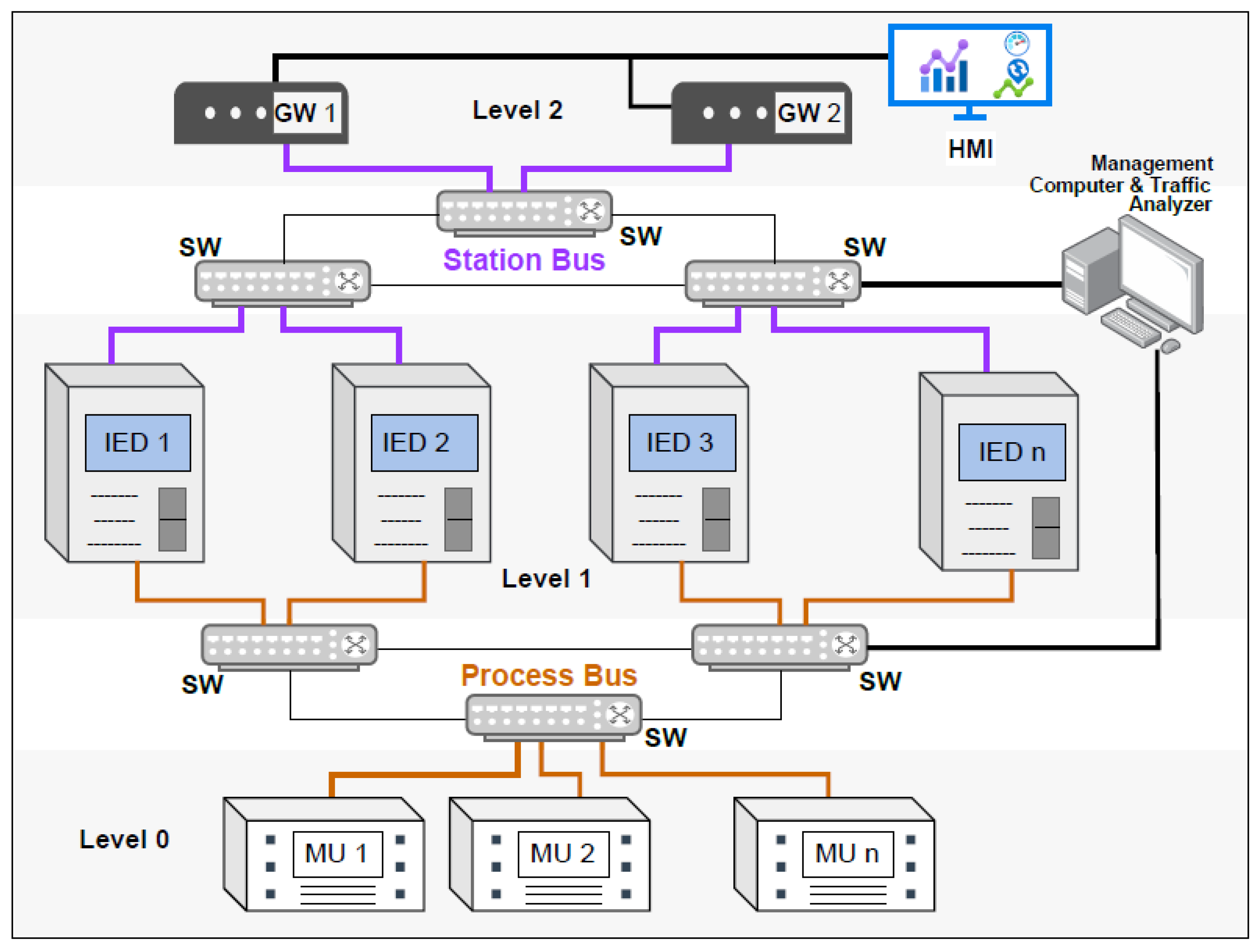
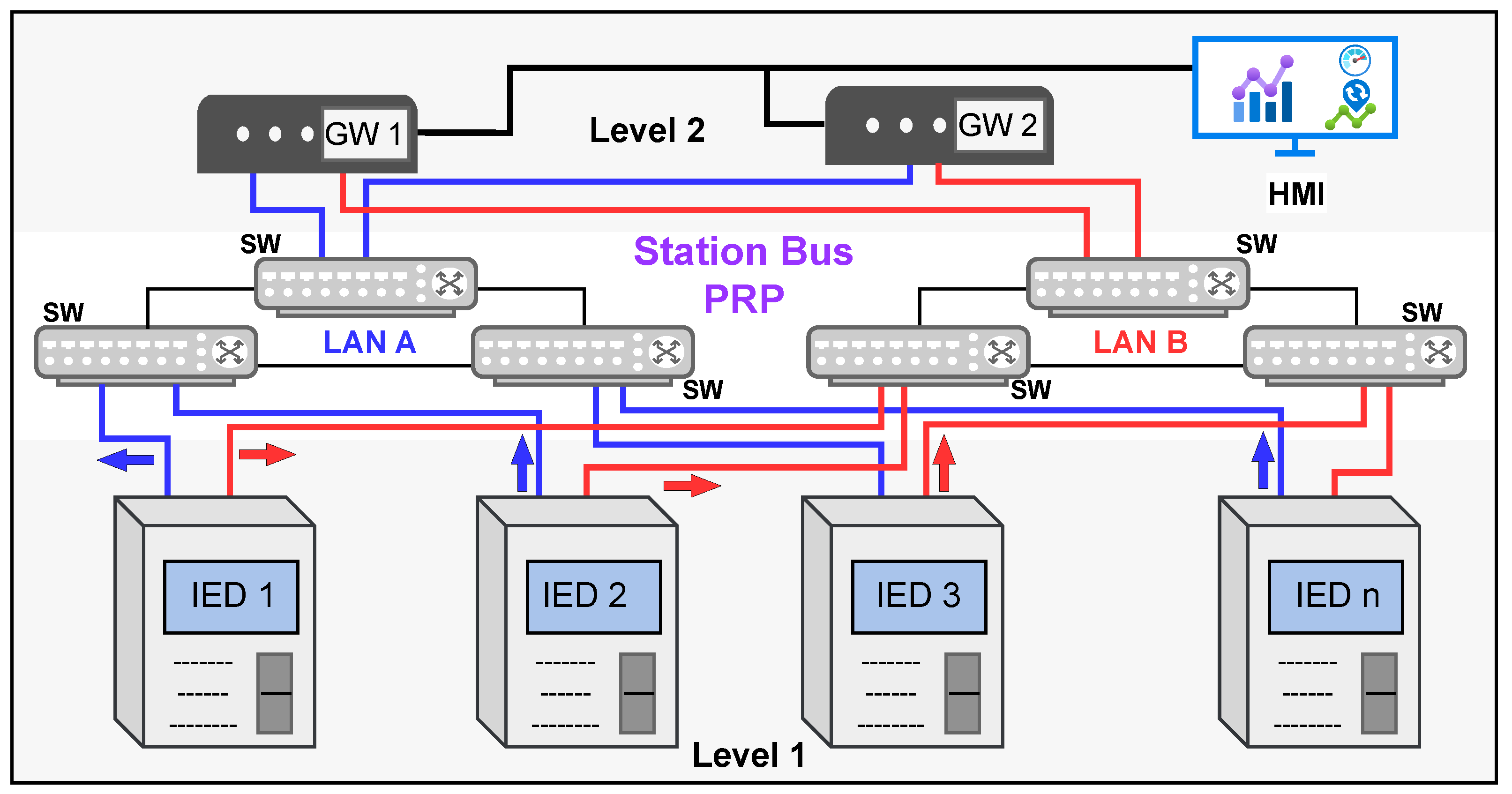

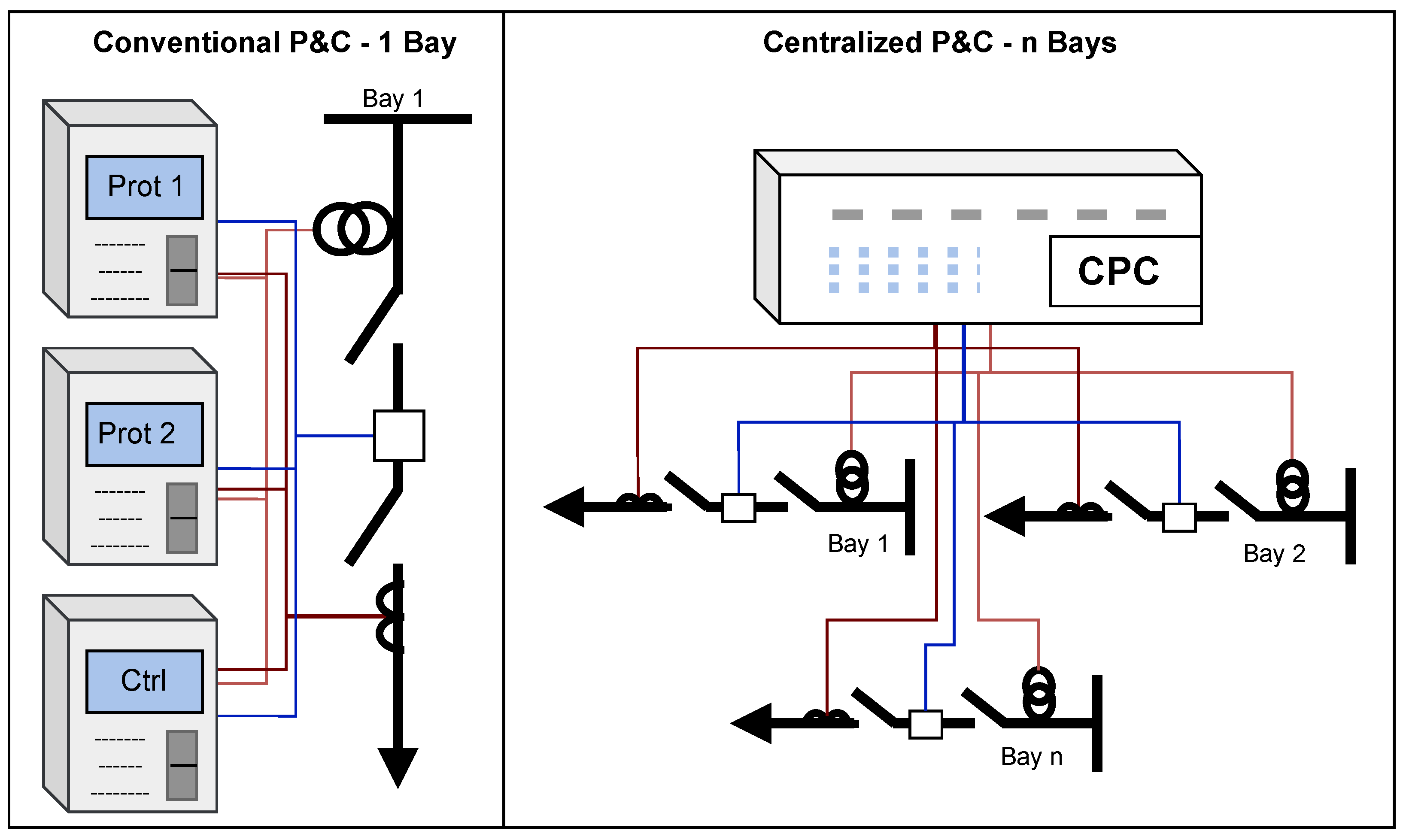

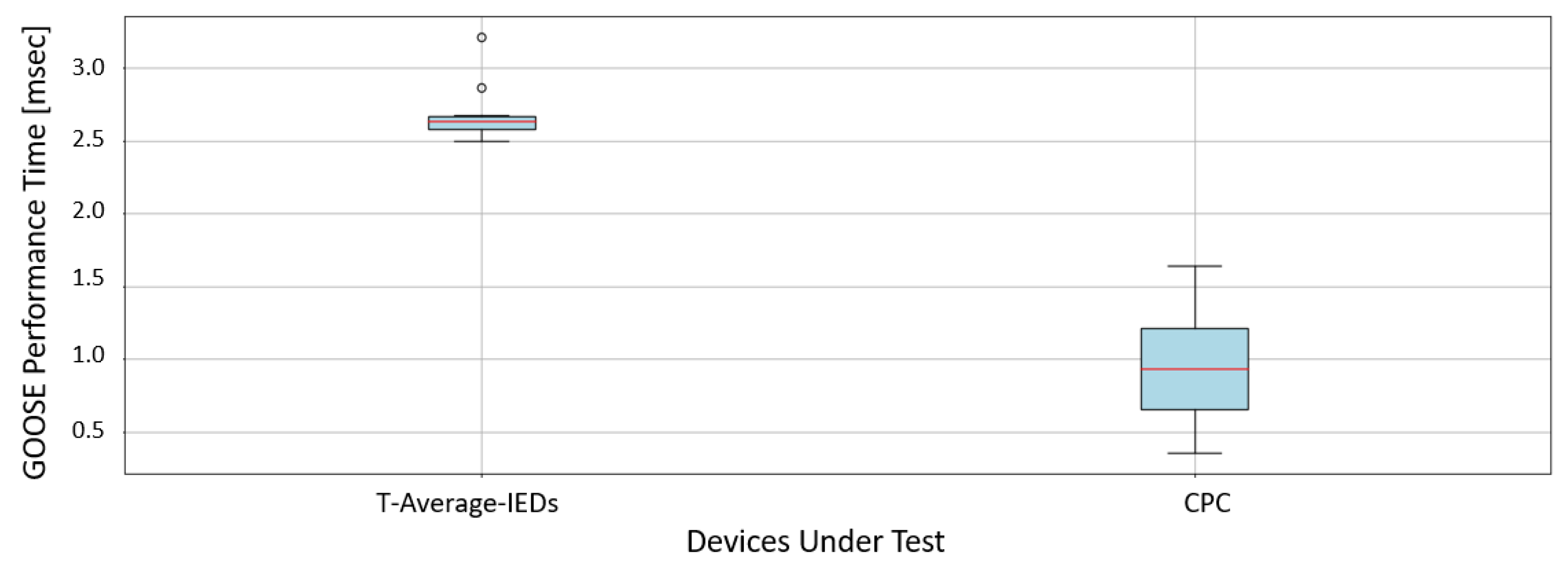
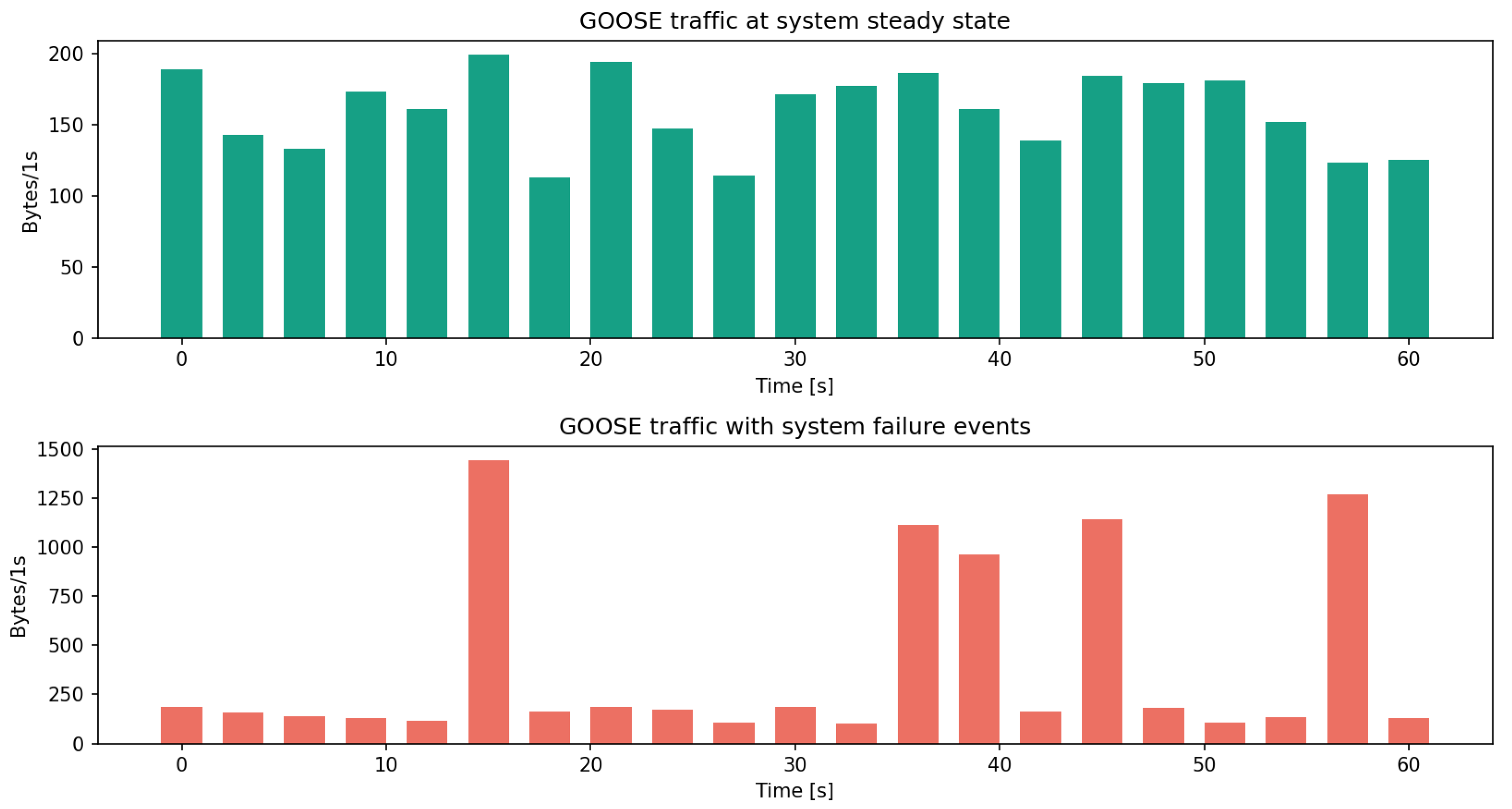
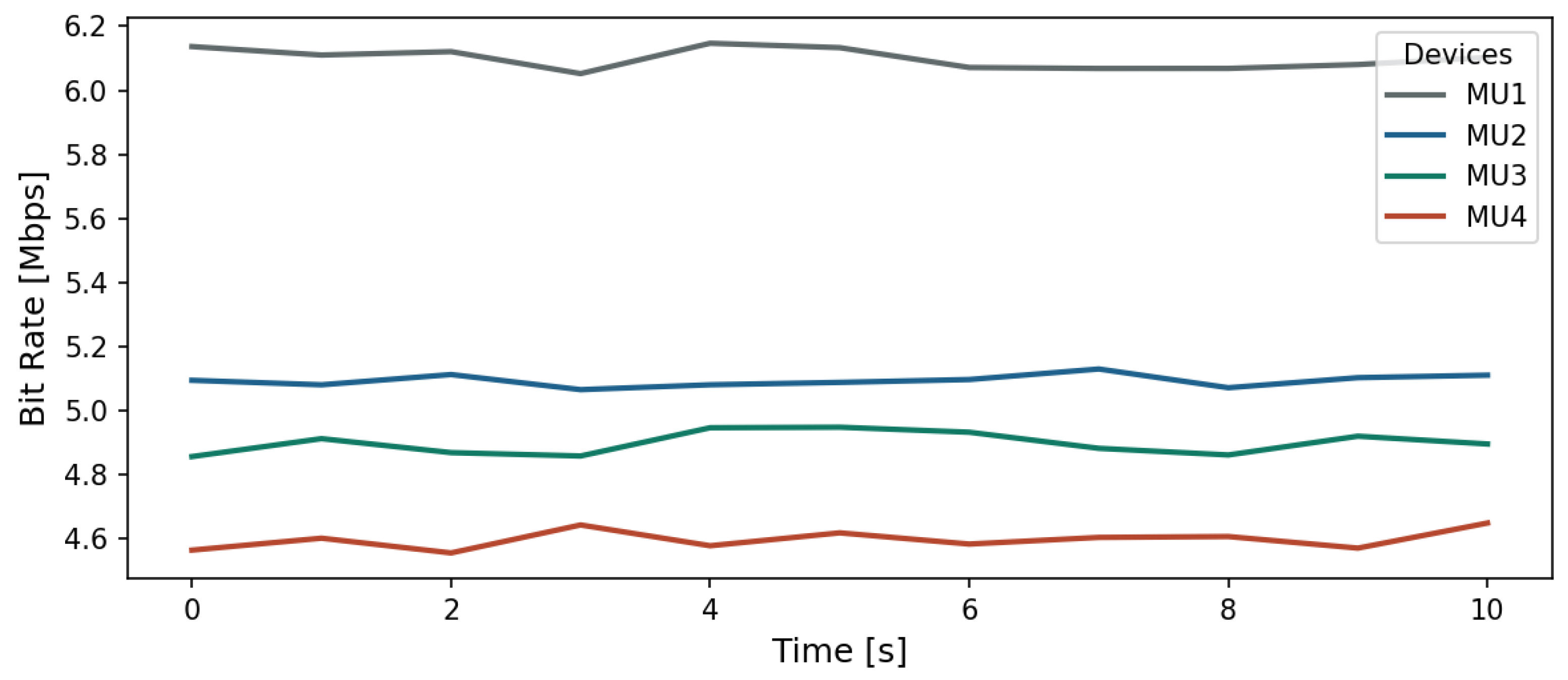
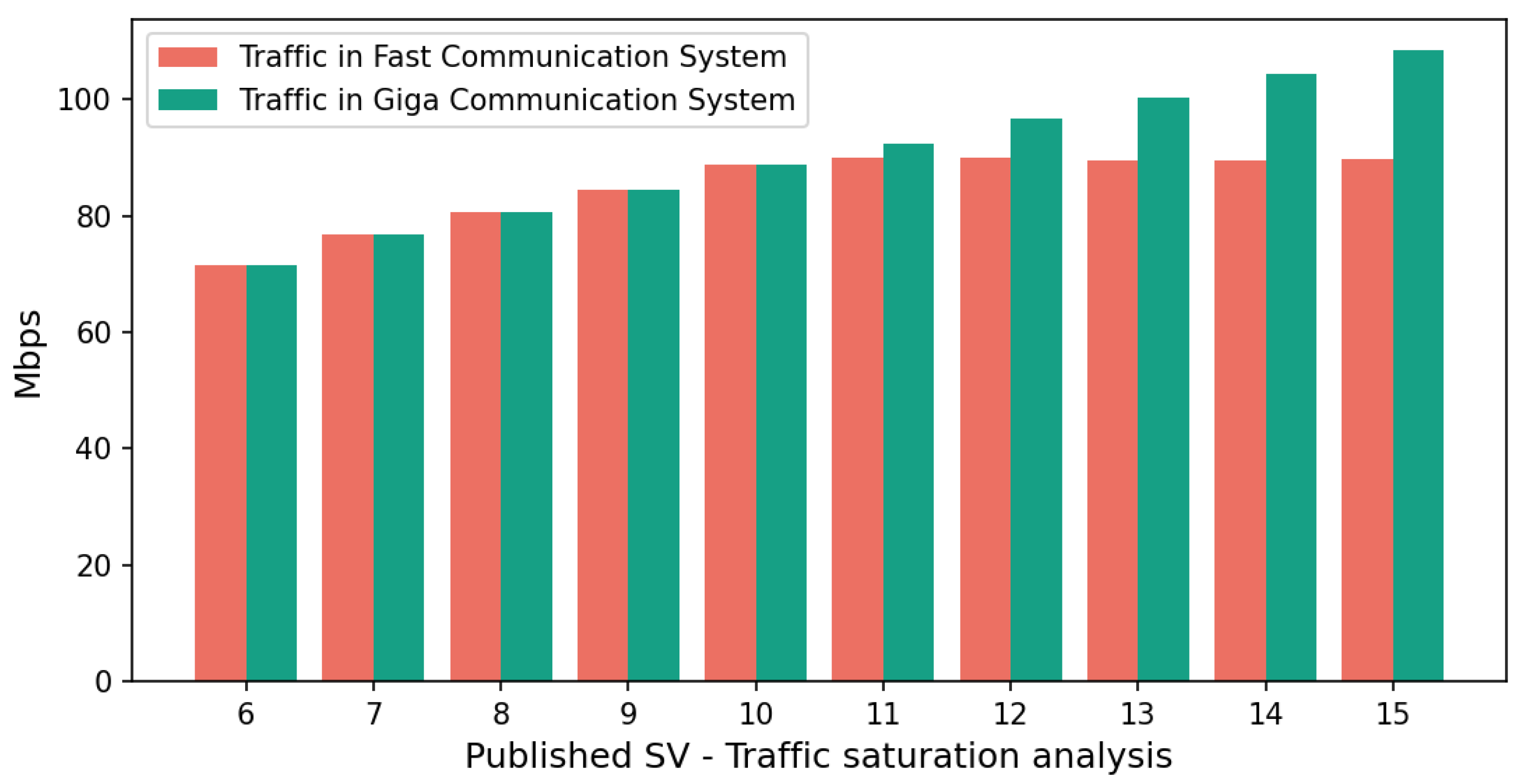
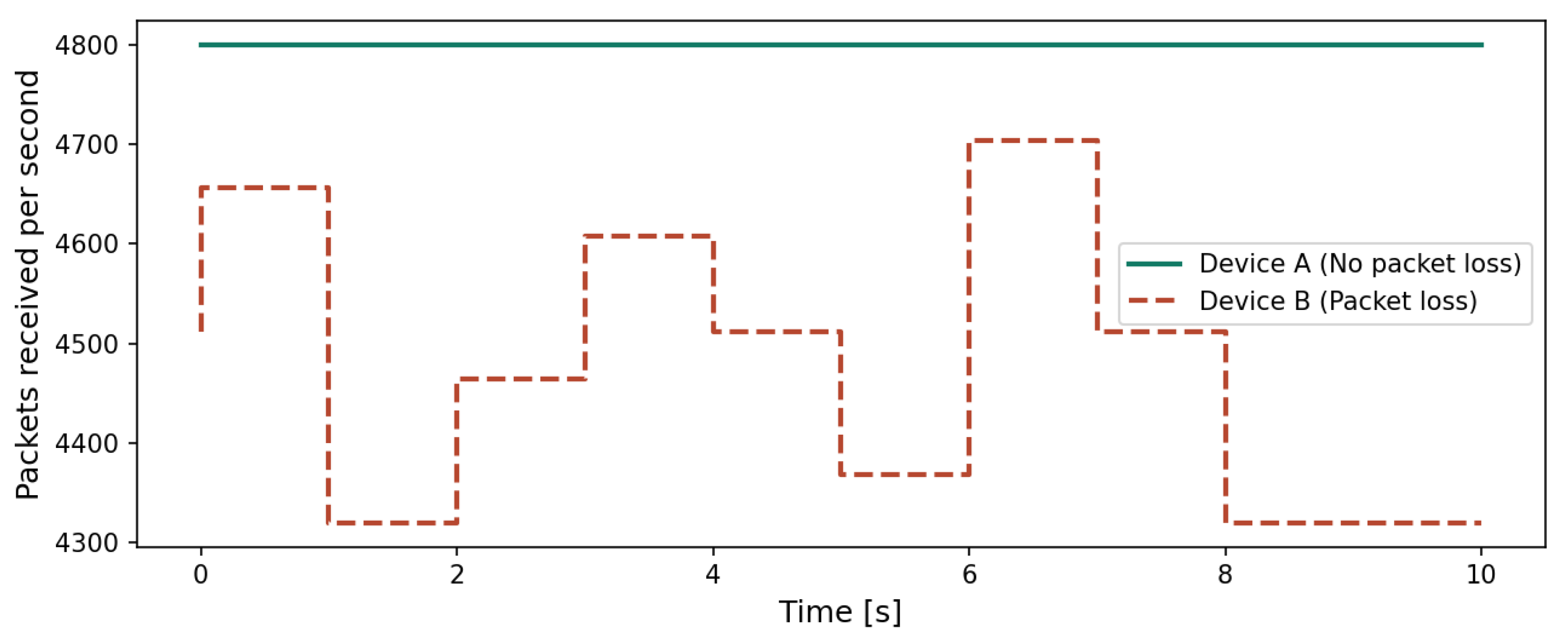
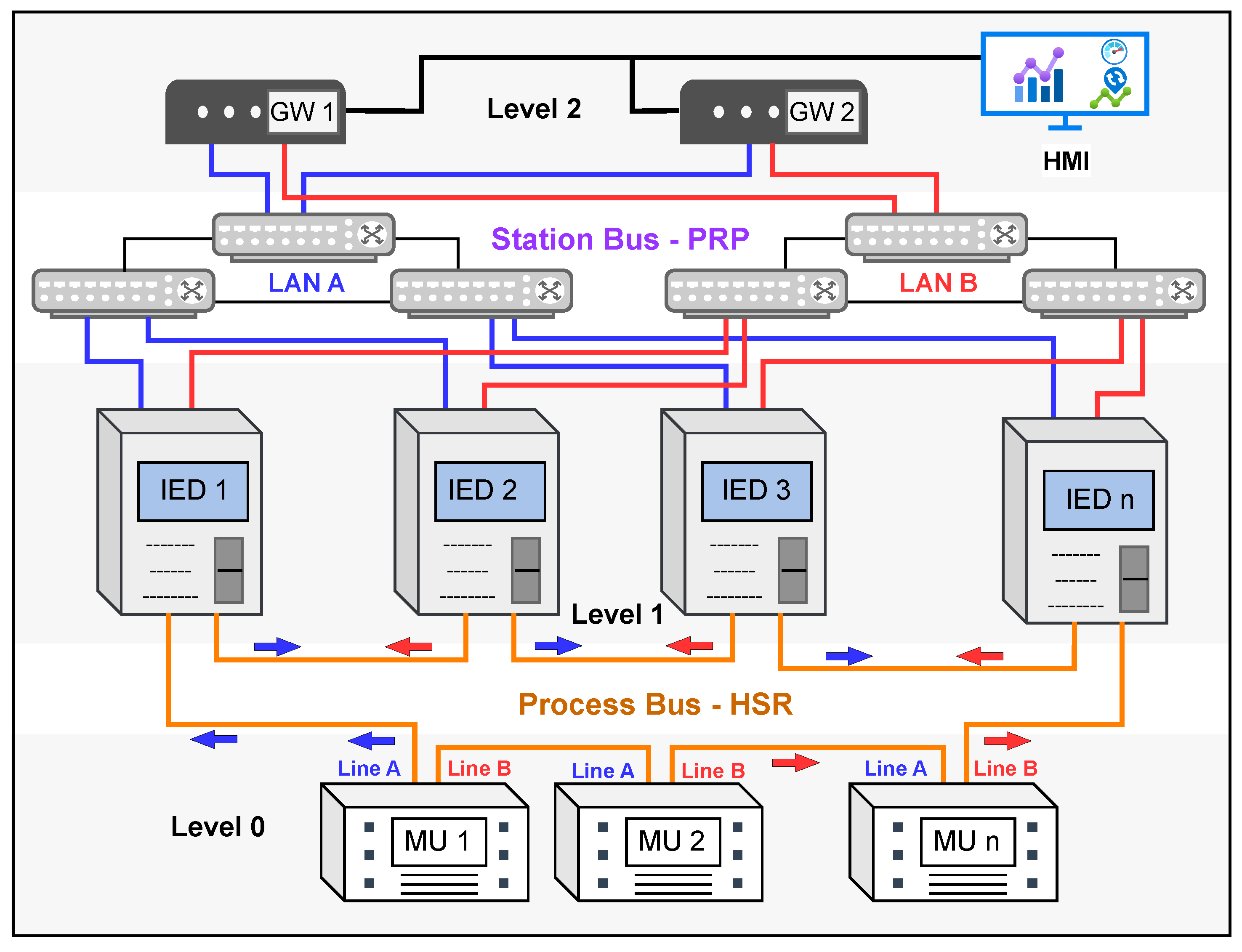
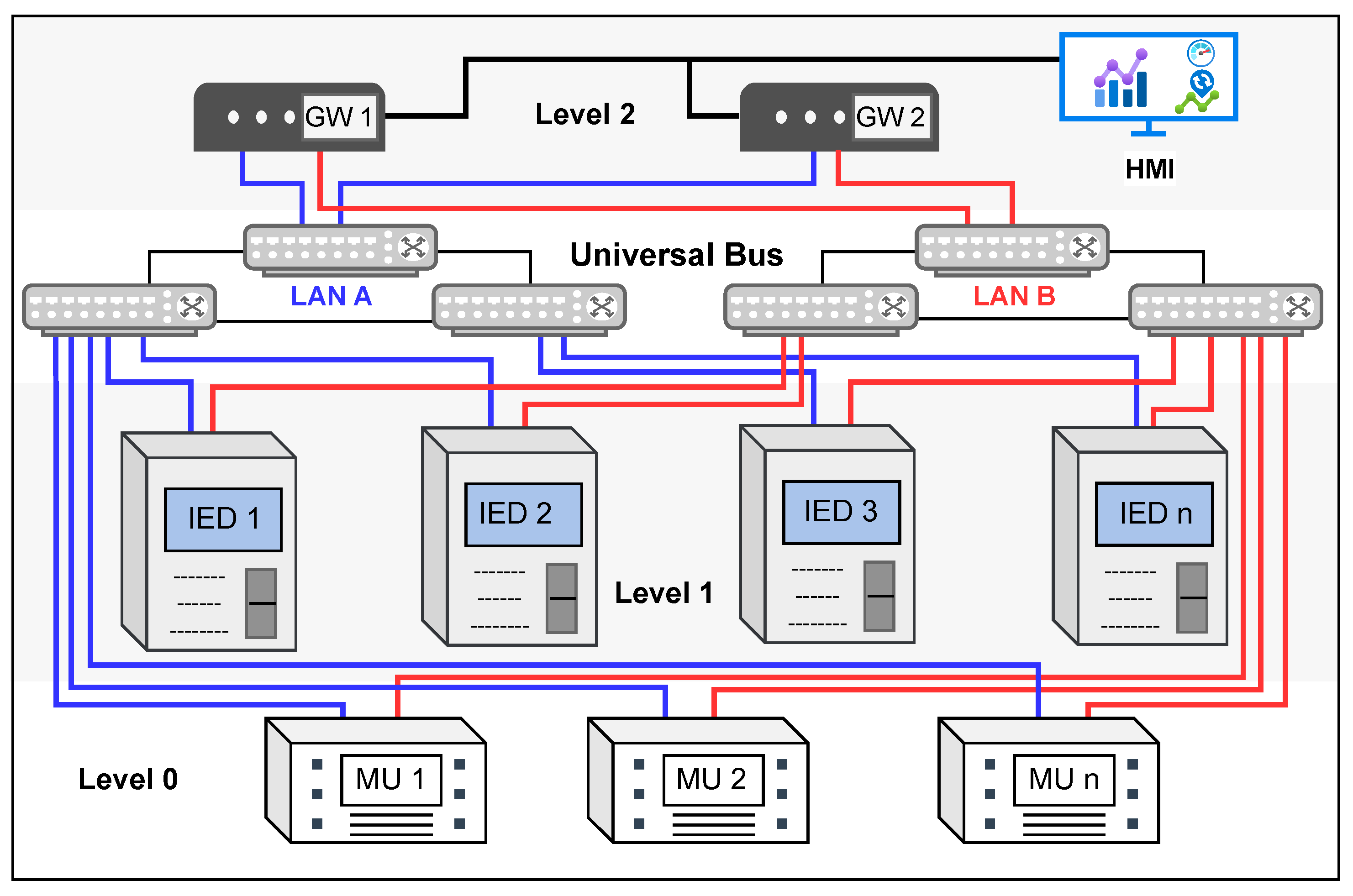
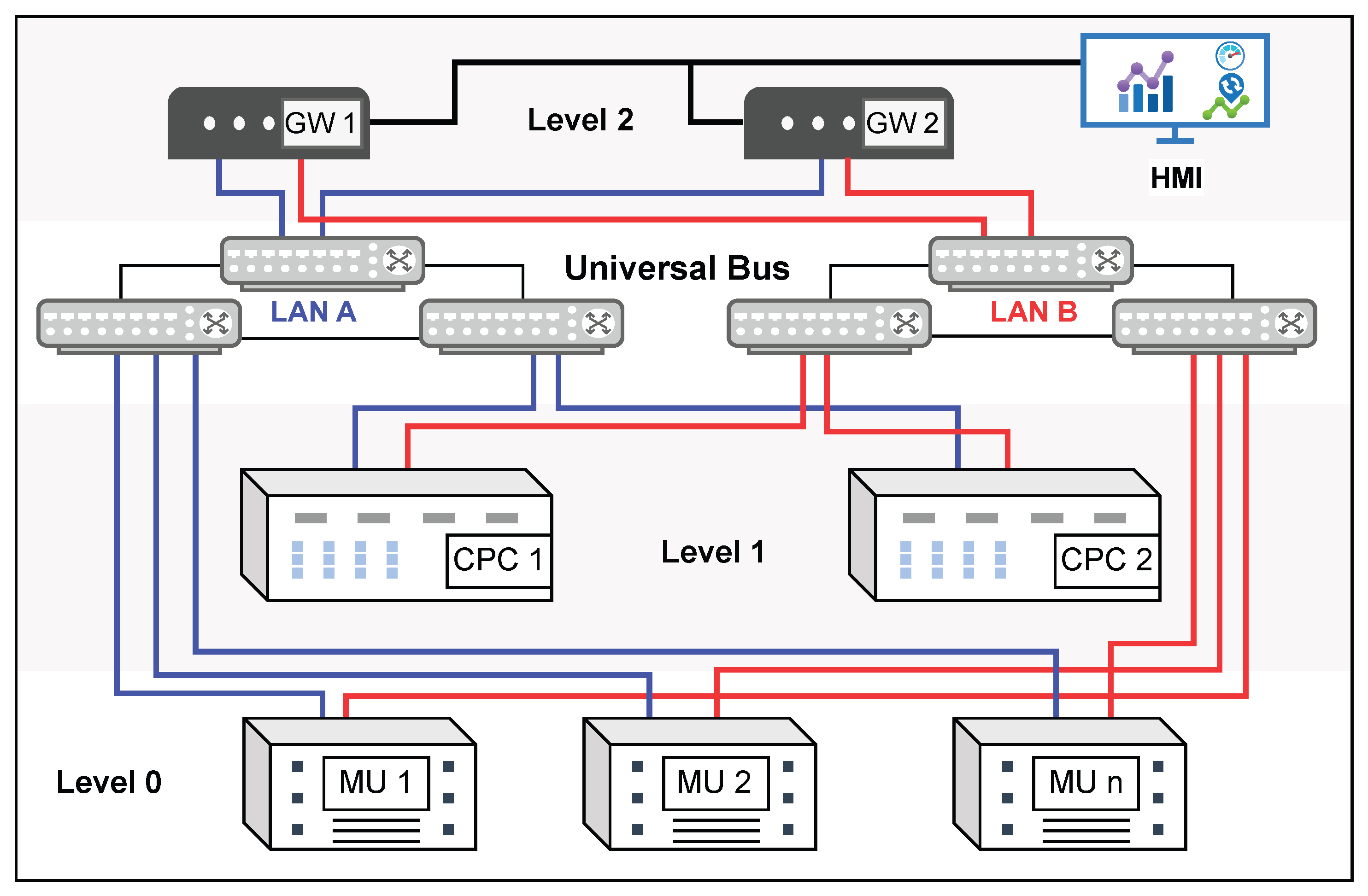
| Architecture Type (Conventional Digital Systems) | |||
|---|---|---|---|
| DES Infrastructure requirements per bay | Basic star—simple (non-redundant) | Double star—PRP redundancy | Ring—HSR redundancy |
| Gateways | at least 2 * | ||
| IEDs | at least 2 or 3 * | ||
| Merging Units | at least 2 * | ||
| GPS | at least 1 | ||
| Switches | at least 2 | at least 4 | none |
| Communication channels | at least 8 | at least 16 | at least 8 |
| Architecture Type (Conventional Digital Systems) | |||
|---|---|---|---|
| DES Infrastructure requirements per bay | Basic star—simple (non-redundant) | Double star—PRP redundancy | Ring—HSR redundancy |
| Gateways | US$21,000 | ||
| IEDs | US$19,000–US$28,000 | ||
| MUs | US$12,000 | ||
| GPS | US$8000 | ||
| Switches | US$8000 | US$16,000 | none |
| Communication channels | US$2000 | US$4000 | US$2500 |
| Architecture Type (Conventional Digital Systems) | |||
|---|---|---|---|
| DES Infrastructure requirements per bay | Basic star—simple (non-redundant) | Double star–PRP redundancy | Ring—HSR redundancy |
| Gateways | 150 W | ||
| IEDs | 160–240 W | ||
| MUs | 90 W | ||
| GPS | 40 W | ||
| Switches | 140 W | 280 W | none |
| Communication channels | none | none | none |
| Communication Protocol | Size [Bytes/s] * | |
|---|---|---|
| MMS | 12.5 k | |
| GOOSE | Heavy (burst/Trips) (e.g., “during fault events”) | 125 k |
| GOOSE | Lite (steady state) | 125 |
| Sampled Values | 4.8–6.2 M | |
| Approach | Traditional Architecture | Substation Centralized Equipment |
|---|---|---|
| Relay Asset Management Device Management | Many relays must be identified, specified, configured, tested, and maintained separately, along with separate records for each device. Each protection IED in a substation usually has numerous configuration options to enable various features. | A limited number of devices need to be identified, specified, configured, tested, and maintained, along with separate records for each device. A small number of devices makes it easy to manage, and also the feature set is reduced and limited compared to traditional methods. |
| Maintenance | Routine maintenance can be frequent and require experienced and well-trained personnel along with expensive calibrated test equipment. P&C IED maintenance per bay is easily accomplished due to the bay-separated IEDs. | Limited maintenance is required as the entire substation P&C system uses fewer physical devices, although experienced personnel are still required for maintenance. More robust and reliable systems can be designed at a lower cost. |
| Security | Multitude of protection IEDs Provides more access points for cyber threats. | Very limited number of access points that can also be better managed. |
| Interoperability | Disparate protocols that are difficult to standardize. Substation Automation System modifications can be complicated. | It primarily leverages IEC 61850 technology and can be more easily adopted than the distributed protection IED model. Substation engineers are required to have networking knowledge. |
| Substation Master Interface | Depending on the technology, the protection IED may not be able to be monitored by an RTU or data concentrator. Newer technologies have protective IEDs with limited computation and communication interfaces to transfer data in and out of the substation. | The CPC becomes the “Gatekeeper” of dynamic device models. Relays are ubiquitous. This provides a master smart node for interaction between substations and control centers. Tremendous reduction in communication needs. |
| Approach | Current Architecture | Architecture 1 Optimization Alternative | Architecture 2 Universal Bus | Architecture 3 Universal Bus and CPC |
|---|---|---|---|---|
| Relay Asset Management Device Management | Reduced | Reduced only in communications | Reduced single bus process | Significantly reduced |
| Maintenance | Low | Low | Low | Very low |
| Security | High | Medium | Medium | High |
| Interoperability | Medium | Medium | Medium | High |
| Substation Master Interface | Unique | It depends on the technology of each IED | It depends on the technology of each IED | Unique |
| Built area | High | High | Medium | Low |
| IED quantity | Medium | Medium–high | Medium | Low |
| Implementation time * | 6 to 8 months | 6 to 8 months | 4 to 7 months | 1 to 3 months |
| Deenergization is required for maintenance | Yes | No (redundant protection) | No (redundant protection) | No |
| Implementation Cost | Middle | Medium–High | Medium–Low | Very Low |
| Architecture | Cost Reduction (US$/bay) | Resource Improvement | Trade-Off Considerations |
|---|---|---|---|
| Current (PRP) | Baseline (US$70,000) | High redundancy | High equipment count |
| Universal Bus | ∼US$8000 (switches) | Up to 50% less equipment | Higher traffic load |
| Universal Bus + CPC | ∼US$27,000 (IEDs) | 50% faster response | Centralized failure risk |
Disclaimer/Publisher’s Note: The statements, opinions and data contained in all publications are solely those of the individual author(s) and contributor(s) and not of MDPI and/or the editor(s). MDPI and/or the editor(s) disclaim responsibility for any injury to people or property resulting from any ideas, methods, instructions or products referred to in the content. |
© 2025 by the authors. Licensee MDPI, Basel, Switzerland. This article is an open access article distributed under the terms and conditions of the Creative Commons Attribution (CC BY) license (https://creativecommons.org/licenses/by/4.0/).
Share and Cite
Tobar-Rosero, O.A.; Díaz-Mendoza, O.D.; Díaz-Vargas, P.A.; Candelo-Becerra, J.E.; Florez-Célis, H.A.; Quintero-Henao, L.F. Digital Substations: Optimization Opportunities from Communication Architectures and Emerging Technologies. Sci 2025, 7, 63. https://doi.org/10.3390/sci7020063
Tobar-Rosero OA, Díaz-Mendoza OD, Díaz-Vargas PA, Candelo-Becerra JE, Florez-Célis HA, Quintero-Henao LF. Digital Substations: Optimization Opportunities from Communication Architectures and Emerging Technologies. Sci. 2025; 7(2):63. https://doi.org/10.3390/sci7020063
Chicago/Turabian StyleTobar-Rosero, Oscar Andrés, Octavio David Díaz-Mendoza, Paola Andréa Díaz-Vargas, John E. Candelo-Becerra, Héctor Andrés Florez-Célis, and Luis Fernando Quintero-Henao. 2025. "Digital Substations: Optimization Opportunities from Communication Architectures and Emerging Technologies" Sci 7, no. 2: 63. https://doi.org/10.3390/sci7020063
APA StyleTobar-Rosero, O. A., Díaz-Mendoza, O. D., Díaz-Vargas, P. A., Candelo-Becerra, J. E., Florez-Célis, H. A., & Quintero-Henao, L. F. (2025). Digital Substations: Optimization Opportunities from Communication Architectures and Emerging Technologies. Sci, 7(2), 63. https://doi.org/10.3390/sci7020063








